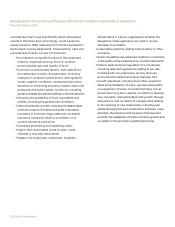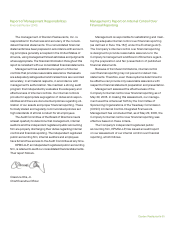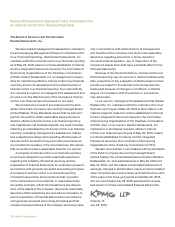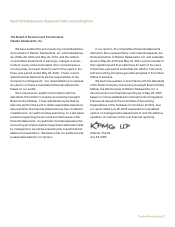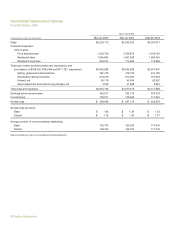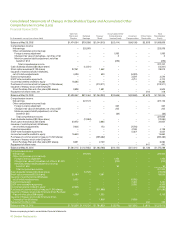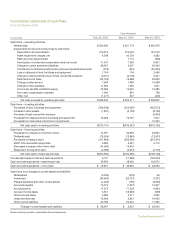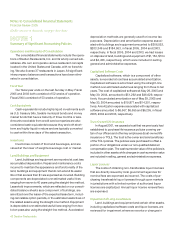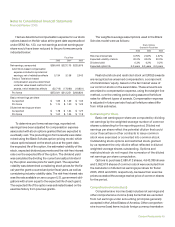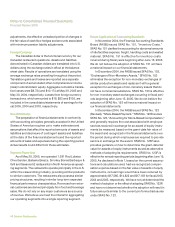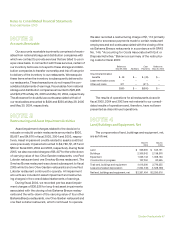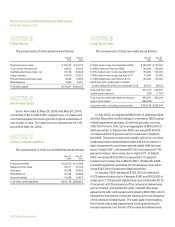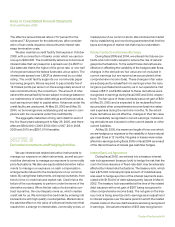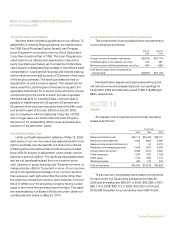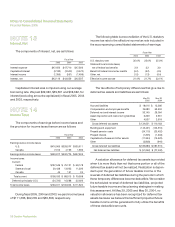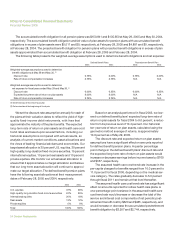Red Lobster 2005 Annual Report Download - page 36
Download and view the complete annual report
Please find page 36 of the 2005 Red Lobster annual report below. You can navigate through the pages in the report by either clicking on the pages listed below, or by using the keyword search tool below to find specific information within the annual report.Notes to Consolidated Financial Statements
Financial Review 2005
44 Darden Restaurants
and hedged items, as well as our risk-management objective
and strategy for undertaking the various hedge transactions.
This process includes linking all derivatives designated as
cash flow hedges to specific assets and liabilities on the con-
solidated balance sheet or to specific forecasted transactions.
We also formally assess, both at the hedge’s inception and
on an ongoing basis, whether the derivatives used in hedg-
ing transactions are highly effective in offsetting changes in
cash flows of hedged items.
Changes in the fair value of derivatives that are highly
effective and that are designated and qualify as cash flow
hedges are recorded in other comprehensive income until
earnings are affected by the variability in cash flows of the
designated hedged item. Where applicable, we discontinue
hedge accounting prospectively when it is determined that
the derivative is no longer effective in offsetting changes in
the cash flows of the hedged item or the derivative is termi-
nated. Any changes in the fair value of a derivative where
hedge accounting has been discontinued or is ineffective
are recognized immediately in earnings. Cash flows related
to derivatives are included in operating activities.
Operating Leases
We recognize rent expense on a straight-line basis over
the expected lease term, including cancelable option periods
when it is deemed to be reasonably assured that we would
incur an economic penalty for not exercising the options.
Within the provisions of certain of our leases, there are rent
holidays and/or escalations in payments over the base lease
term, as well as renewal periods. The effects of the holidays
and escalations have been reflected in rent expense on a
straight-line basis over the expected lease term, which
includes cancelable option periods when it is deemed to be
reasonably assured that we would incur an economic penalty
for not exercising the option. The lease term commences on
the date when we have the right to control the use of the
leased property, which is typically before rent payments are
due under the terms of the lease. Many of our leases have
renewal periods totaling five to 20 years, exercisable at our
option and require payment of property taxes, insurance and
maintenance costs in addition to the rent payments. Per-
centage rent expense is generally based on sales levels and
is accrued at the point in time we determine that it is proba-
ble that such sales levels will be achieved.
Pre-Opening Expenses
Non-capital expenditures associated with opening new
restaurants are expensed as incurred.
Advertising
Production costs of commercials are charged to oper-
ations in the fiscal period the advertising is first aired. The
costs of programming and other advertising, promotion
and marketing programs are charged to operations in the
fiscal period incurred. Advertising expense amounted to
$214,608, $210,989 and $200,020, in fiscal 2005, 2004
and 2003, respectively.
Stock-Based Compensation
Statement of Financial Accounting Standards (SFAS)
No. 123, “Accounting for Stock-Based Compensation,”
encourages the use of a fair-value method of accounting
for stock-based awards under which the fair value of stock
options is determined on the date of grant and expensed over
the vesting period. As allowed by SFAS No. 123, we have
elected to account for our stock-based compensation plans
under an intrinsic value method that requires compensation
expense to be recorded only if, on the date of grant, the cur-
rent market price of our common stock exceeds the exercise
price the employee must pay for the stock. Our policy is to
grant stock options at the fair market value of our underlying
stock on the date of grant. Accordingly, no compensation
expense has been recognized for stock options granted
under any of our stock plans because the exercise price of
all options granted was equal to the current market value
of our stock on the grant date.


